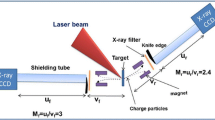Abstract
Hot electrons produced by ultra-short pulse laser interacting with solid targets were studied systematically. When 800 nm, 8 × 1015 W/cm2 laser pulses interacted with solid targets, hot electron emission was found to be collimated in certain directions and the angular distribution of hot electrons depended on the energy absorption. The angular divergence of outgoing hot electrons was inversely proportional to the hot electron energy. The energy spectrum of hot electrons was found to be in a biMaxwellian distribution and the maximum energy was over 500 keV.
Similar content being viewed by others
References
Tabak, M., Hammer, J., Glinsky, M. E. et al., Ignition and high gain with ultrapowerful lasers, Phys. Plasmas, 1994, 1 (5): 1626.
Wilks, S. C., Kruer, W. L., Tabak, M. et al., Absorption of ultra-intense laser pulses, Phys. Rev. Lett., 1992, 69 (9): 1383.
Rousseaus, C., Amiranoff, F., Labaune, C. et al., Superthermal and relativistic electrons produced in laser-plasma interaction at 0.26, 0.53, and 1.05 μm laser wavelength, Phys. Fluids B, 1992, 4(8): 2589.
Malka, G., Miquel, J. L., Experimental confirmation of ponderomotive-force electrons produced by an ultrarelativistic laser pulses on a solid target, Phys. Rev. Lett., 1996, 77(1): 75.
Malka, G., Lefebvre, E., Miquel, J. L., Experimental observation of electrons accelerated in vacuum to relativistic energies by a high-intensity laser, Phys. Rev. Lett., 1997,78(17): 3314.
Malka, G., Fuchs, J., Amiranoff, F. et al., Suprathermal electron generation and formation by an ultrarelativistic laser pulse in an underdense preformed plasma, Phys. Rev. Lett., 1997, 79(11) ; 2053.
Kruer, W. L., Estabrook, K., J × B heating by very intense laser light, Phys. Fluids., 1985, 28(1): 430.
Bastiani, S., Rousse, A., Geindre, J. P. et al., Experimental study of the interaction of subpicosecond laser pulses with solid targets of varying initial scale lengths, Phys. Rev. E., 1997, 56(6): 7179.
Sentoku, Y., Ruhl, H., Mima, K. et al., Plasma jet formation and magnetic-field generation in the intense laser plasma under oblique incidence, Phys. Plasmas, 1999, 6(7): 2855.
Brunel, F., Not-so-resonant, resonant absorption, Phys. Rev. Lett., 1987, 59(1): 52.
Brunel, F., Anomalous absorption of high intensity subpicosecond laser pulses, Phys. Fluids., 1988, 31(9): 2714.
Rousse, A., Audebert, P., Geindre, J. P. et al., Efficient Kα X-ray source from femtosecond laser-produced plasmas, Phys. Rev. E., 1994, 50(3), 2200.
Fews, A. P., Norreys, P. A., Beg, F. N. et al., Plasma ion emission from high intensity picosecond laser pulse interactions with solid targets, Phys. Rev. Lett., 1994, 73(13): 1801.
Schnurer, M., Kalashnikov, M. P., Nickles, P. V. et al., Hard X-ray emission from intense short pulse laser plasmas, Phys. Plasmas., 1995, 2(8): 3106.
Key, M. H., Cable, M. D., Cowan, T. E. et al., Hot electron production and heating by hot electrons in fast ignitior research, Phys. Plasmas, 1998, 5(5): 1966.
Fowler, J. F., Attix, F. H., Solid State Integrating Dosimeter in Radiation Dosimeter, Vol. 11, 2nd ed., Reading, MA:Addison-Wesley, 1966.
Moore, C. I., Ting, A., McNaught, S. J. et al., A laser-accelerator injector based on laser ionization and ponderomotive acceleration of electrons, Phys. Rev. Lett., 1999, 82(8): 1688.
Estabrook, K., Kruer, W. L., Properties of resonantly heated electron distributions, Phys. Rev. Lett., 1977, 40(l): 42.
Kruer, W. L., The Physics of Laser Plasma Interactions, Reading, MA: Addison-Wesley, 1988, 38.
Fabbro, R., Max, C., Fabro, E., Planar laser-driven ablation: Effect of inhibited electron thermal conduction, Phys. Fluids, 1985, 28(5): 1463.
Author information
Authors and Affiliations
Corresponding author
Rights and permissions
About this article
Cite this article
Chen, L., Zhang, J., Li, Y. et al. Hot electrons generated by ultra-short pulse laser interacting with solid targets. Sci. China Ser. A-Math. 43, 1294–1300 (2000). https://doi.org/10.1007/BF02880066
Received:
Revised:
Issue Date:
DOI: https://doi.org/10.1007/BF02880066




